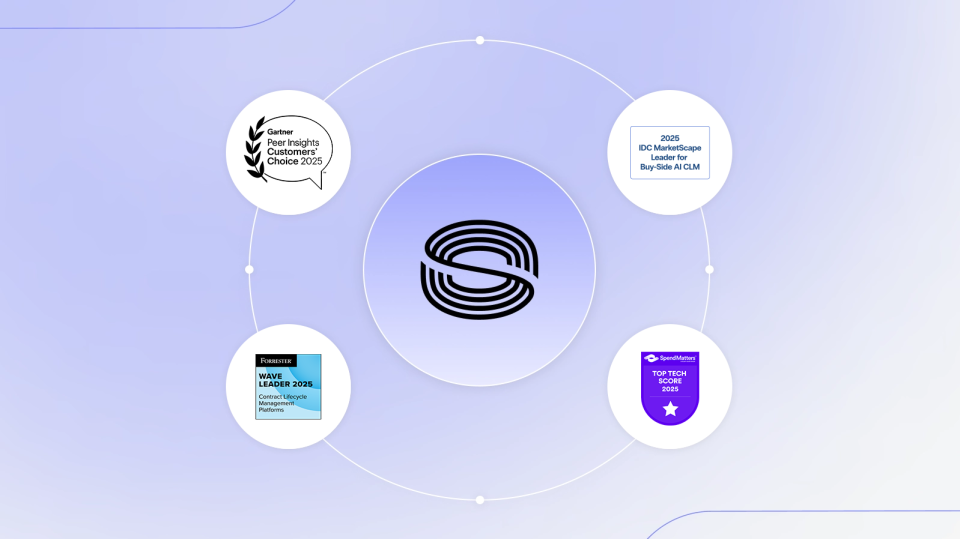Effective CLM Tools: 3 Step Guide to Selecting the Best Solution

- Last Updated: Dec 23, 2025
- 15 min read
- Sirion
Contract Lifecycle Management (CLM) tools are essential in today’s business environment, helping companies efficiently manage contracts across their lifecycle—from drafting and negotiation to execution, performance tracking, and renewal. Choosing the right CLM tool can be daunting, given the diverse needs of various departments, the scale of operations, and existing tech infrastructure. Here’s how to find the best CLM tool for your organization.
Before diving into how to choose the right CLM tool, it’s important to understand the common challenges organizations face in managing contracts across their lifecycle.
What Are the Challenges Associated with Contract Management?
- Fragmented processes: Contracts are often created, reviewed, and stored in disconnected tools, leading to version control issues and loss of critical data.
- Manual effort and bottlenecks: Teams spend hours drafting, reviewing, and tracking contracts, causing delays and draining productivity.
- Limited visibility: Without a central repository or performance tracking, organizations often miss key obligations, renewal dates, or compliance risks.
- Inefficient collaboration: Cross-functional teams (legal, procurement, finance) frequently operate in silos, slowing down approvals and increasing friction.
- Risk exposure and value leakage: Lack of standardization and oversight increases the chances of non-compliance, revenue loss, and contractual disputes.
These issues are amplified as contract volume and complexity grow, making it critical for businesses to evolve beyond spreadsheets and email-based workflows.
These challenges are exactly what CLM tools are built to solve. But what exactly is a CLM tool—and what should you expect from one?
What Is a CLM Tool and What Does It Do?
A Contract Lifecycle Management (CLM) tool is software that automates and streamlines the entire lifecycle of a contract, from initiation and authoring to negotiation, execution, performance tracking, and renewal.
Key capabilities of a modern CLM tool include:
- Contract creation and authoring with templates, clause libraries, and guided workflows
- Automated approvals and e-signature integrations to shorten cycle times
- Centralized contract repository for storing and retrieving contracts securely
- Search and analytics to extract insights and track milestones
- Post-signature obligation and performance management
- Compliance and risk management through deviation tracking and audit trails
- AI-powered tools for data extraction, redlining, and intelligent recommendations
By bringing structure, speed, and intelligence to the contract process, CLM tools help organizations move from reactive contract handling to proactive contract strategy.
Now that we’ve defined what a CLM tool does, let’s explore how it directly addresses the pain points faced across legal, procurement, sales, and other business teams.
How CLM Tools Help Address These Challenges
CLM tools are designed to resolve the very issues that make contract management inefficient, error-prone, and risky. Here’s how:
| Challenge | How CLM Tools Solve It |
| Fragmented processes | Centralize contracts in a searchable, digital repository with audit trails. |
| Manual effort | Automate drafting, review, approval, and renewal tracking. |
| Lack of visibility | Use dashboards and alerts to track obligations, risks, and deadlines in real time. |
| Collaboration silos | Enable real-time collaboration, version control, and role-based access. Supports virtual collaboration with cloud access, secure permissions, and real-time version control for distributed teams. |
| Risk and value leakage | Standardize language with clause libraries and identify deviations early using AI. |
In essence, CLM tools shift contract management from a reactive chore to a strategic enabler—improving speed, accuracy, compliance, and collaboration across the organization.
3-Step Guide to Choosing an Effective CLM Tool
Selecting the right CLM tool involves a structured decision-making process to ensure the tool meets the specific needs of your organization. By breaking this process into three major stages—Assess, Evaluate, and Discover—you can methodically determine which CLM solution is the best fit. Here’s a step-by-step guide for each stage.
Step 1: Assess the need for the CLM Tool
Before evaluating CLM options, it’s essential to first consider the specific challenges and needs of your organization.
- Pain Points of Different Departments
- Legal: How much time is spent on contract drafting, review, and approval? Are there bottlenecks slowing down the legal process?
- Procurement: How effectively are supplier contracts managed? Is there a lack of visibility into contract expiration dates or compliance risks?
Sales: Does the sales team struggle with slow approvals that impact revenue generation? - Finance: Are there challenges in auditing invoices against contracts? Are payment terms consistently enforced?
- Operations: Can the team easily track contract performance, obligations, and milestones?
Understanding each department’s specific pain points is essential in choosing a CLM tool that addresses these challenges.
- Scale of Operations and Contracting
Assess the volume of contracts you currently manage and consider future growth.
• Consider the complexity of contracts across departments (e.g., procurement vs. sales contracts).
• Ensure the CLM tool can scale with your business as your contract volume increases. - Existing Systems and Tech Stack
Inventory your current tech stack—ERP (e.g., SAP, Oracle), CRM (e.g., Salesforce), procurement, or finance systems (P2P, GRC).
• Ensure the CLM tool can integrate with your existing software through APIs or pre-built connectors. - Level of Contract Digitization
Assess your current level of contract digitization. If you’re still working with physical or fragmented digital contracts, look for a CLM tool that offers bulk ingestion, AI-powered extraction, and centralized contract storage.
Step 2: Evaluate the CLM Tool
After assessing your organization’s needs, the next step is to evaluate the various CLM tools available.
- What CLM Tools Are Available?
• Identify leading CLM tools by researching the market.
• Create a shortlist of solutions based on features, scalability, and overall fit for your business. - What CLM Tool Best Suits Your Needs?
• Compare how each CLM tool addresses the pain points identified in the “Assess” stage.
• Look for a tool with pre-built industry-specific packages or a system tailored to departmental needs (e.g., buy-side contracts for procurement, sell-side for sales). - What Do Analyst Reports and Peer Reviews Say?
• Refer to reports from Gartner, Forrester, and IDC MarketScape to see which vendors are ranked highly and why.
• Review user feedback on platforms like and Capterra to gain insights from peers in your industry.
• Consider CLM tools with high ratings, especially in the areas relevant to your implementation.
Step 3: Discover the CLM Tool
The final stage involves learning from , testing features, and assessing the overall fit of the solutions.
1. Take Software Demos – Request Demos and Engage Key Stakeholders
Involve stakeholders from legal, procurement, finance, sales, and operations to assess critical features during the demo. Test the tool using sample contracts and workflows to evaluate:
- Integration: Ensure seamless integration with your existing systems and confirm that the tool meets your specific requirements.
- User Experience: Is the platform intuitive and easy for all departments to use?
- Collaboration: Can teams collaborate effortlessly in real-time on contract drafting, redlining, and approvals?
- Test Key and Advanced Capabilities:
- AI-Powered Automation: Assess how effectively the AI automates data extraction, contract reviews, and workflows.
- Performance Tracking: Check for real-time monitoring of obligations, milestones, and compliance.
- Scalability: Confirm that the platform can handle growing contract volumes and increasing
2. Consider Price
• Understand the pricing model—subscription-based, pay-per-contract, or user-based? Ensure the pricing aligns with your budget.
• Check for hidden costs like implementation fees, custom integration charges, or ongoing maintenance.
3. Time to Implement
• Ask vendors for an implementation timeline. Some CLM tools offer faster deployment options or pre-configured setups.
• Consider how long it will take to onboard your teams and integrate the tool with your workflows.
4. Consider Support for Adoption
• Language Support: Does the solution support the languages used by your team? Multinational teams may need multilingual interfaces and customer support.
• Regional Availability: Can the vendor provide support in your region? Is support available 24/7 or limited to certain time zones?
• Training & Onboarding: Check if the vendor offers comprehensive onboarding, training materials, or a dedicated success manager.
Now that you understand how to assess, evaluate, and test CLM tools, it’s equally important to be aware of common mistakes many organizations make during this process. These missteps can undermine your CLM investment, regardless of the platform you choose.
Common Mistakes to Avoid When Choosing a CLM Tool
Even with a structured approach, many organizations fall into common traps when selecting a CLM tool. Avoiding these pitfalls can save time, money, and operational headaches down the line.- Focusing solely on pre-signature capabilities: Some tools excel at drafting and e-signature workflows but offer little value once the contract is signed. Post-signature visibility is critical to realize contractual value.
- Ignoring system integration needs: A CLM tool that can’t integrate with your ERP, CRM, or procurement systems leads to siloed data and broken workflows.
- Underestimating adoption challenges: If the interface is unintuitive or too complex, business users will resist using it, defeating the purpose of streamlining contracts.
- Choosing a tool based only on price: Lower-cost solutions may lack critical features like AI automation, performance tracking, or compliance support, leading to hidden costs later.
- Overlooking implementation and onboarding timelines: A long, resource-heavy implementation can delay ROI. Look for vendors with pre-configured industry solutions or quick-start templates.
CLM Tool Comparison Checklist
Use the following checklist to guide your evaluation and ensure the CLM tool you choose aligns with your organization’s needs, today and as you scale.
Evaluation Criteria | Why It Matters | What to Look For |
Integration Capabilities | Avoid fragmented workflows | Pre-built APIs for ERP, CRM, P2P, e-signature |
Automation & AI | Reduce manual effort and speed up review | Clause extraction, auto-redlining, smart alerts |
Scalability | Supports growth and contract complexity | Handles large volumes, multilingual needs |
Post-Signature Features | Realize contract value | Obligation tracking, performance analytics |
User Adoption | Drives usage across teams | Intuitive UI, collaboration tools, role-based access |
Virtual Collaboration | Ensures seamless contracting across distributed and hybrid teams without version loss or workflow delays. | Cloud-based access, real-time co-authoring, role-based permissions, and automated version control for remote users. |
Compliance & Risk Tools | Reduce legal and audit exposure | Clause deviation alerts, audit trails |
Implementation Speed | Faster time to value | Quick-start templates, dedicated onboarding |
Reporting & Insights | Enables data-driven decisions | Renewal alerts, performance dashboards |
With this checklist in hand, you can move beyond surface-level comparisons and assess how each CLM tool truly aligns with your business goals, tech landscape, and growth plans.
Now, let’s go deeper into the specific capabilities you should expect from a modern CLM tool.
Deep Dive into CLM Tool Features
Scalability, integration, language support, and price are crucial first steps when choosing a CLM tool. But the functionality it offers should meet modern technology standards and go beyond basic contract management. Here’s a look at the key features you should expect:
1. Drafting
A robust CLM tool allows users to draft contracts in minutes. Key features include:
Pre-approved clause and template libraries for fast contract creation.
• A configurable contract playbook to manage risk based on your enterprise’s risk appetite.
• Redline recommendations aligned with your compliance standards.
• Real-time collaboration via online editors or word processing applications.
• Configurable workflows integrated with e-signature tools for expedited execution.
2. Contract Repository and Record-Keeping
An effective CLM tool consolidates contracts into a single source of truth. It should:
• Enable importing contracts from multiple sources, including ERP, CRM, and P2P systems.
• Store contracts, related documents, communications, and notes for comprehensive record-keeping.
3. Risk, Compliance, and Performance Management
CLM tools should help mitigate risks by offering:
• Real-time visibility into regulatory compliance, obligation fulfillment, and service level adherence.
• Automated invoice audits to ensure alignment with contract terms.
• Tools to track performance against contractual milestones.
4. Insights and Analytics
AI-driven insights are critical for proactive contract management. The tool should:
• Provide alerts for upcoming renewals and renegotiation opportunities.
• Use contextual analytics to aid in decision-making for contract renewals.
With Sirion’s CLM tool, you can access all the above features and centralize your organization’s contracts, allowing for quick, accurate answers to every contract-related query using Sirion’s AI. Standardize contracting processes across the enterprise, collaborate seamlessly with stakeholders during negotiations, and close deals faster with AI-powered contract review and auto-redlining. Stay on top of every contractual right and obligation, and monitor performance collaboratively with counterparties to fully realize the value you’ve negotiated.
Sirion’s CLM Leadership: Consistently Ranked #1 by Top Industry Analysts
Sirion has repeatedly secured the top spot across major analyst evaluations, affirming its position as a category leader in Contract Lifecycle Management. From Gartner and Forrester to Spend Matters, Sirion’s AI-native platform is celebrated for its innovation, enterprise-grade functionality, and unmatched post-signature capabilities.
- Gartner Voice of the Customer, 2025: Sirion topped the report for the third year in a row, with 95% of customers saying they would recommend Sirion, and an impressive overall rating of 4.9 out of 5.
- 1 in Spend Matters® (Spring 2025): Sirion topped the CLM rankings for the fourth consecutive time, with its AI-native platform leading in creation, negotiation, search, analytics, and performance management.
- Leader in Forrester CLM Wave™ (2025): Sirion earned top scores for contract execution, analysis, obligation management, and was rated highest for vision, roadmap, and adoption.
- Leader in Gartner® Magic Quadrant™ (2024): Sirion was named a Leader for the third year in a row, recognized for its innovation and depth in both pre- and post-signature CLM capabilities.
What Customers Say: Sirion’s Strengths
Word-of-mouth and market standing are important when assessing the practical benefits of a CLM solution. Sirion, in particular, has received glowing feedback in Gartner Peer Insights for:
- Customer focus: Sirion’s customer-centric support functions are highly praised, ensuring smooth CLM implementation and ongoing support.
- Post-signature capabilities: Sirion’s obligation and performance management features are standouts.
- User experience: The platform is intuitive, easy to use, and comes with an ambitious functionality roadmap.
- Customer focus: Sirion’s customer-centric support functions are highly praised, ensuring smooth CLM implementation and ongoing support.
- Post-signature capabilities: Sirion’s obligation and performance management features are standouts.
User experience: The platform is intuitive, easy to use, and comes with an ambitious functionality roadmap
Unlock the Full Value of CLM with the Right Tool
Choosing the right CLM tool requires thorough evaluation, especially with various departments facing different challenges. Whether you’re looking to streamline drafting, automate performance tracking, or ensure regulatory compliance, a solution like Sirion could meet your needs.
Whether your teams work together in the same office or across regions, Sirion’s AI-Native CLM provides a unified workspace where collaboration, visibility, and accountability stay consistent. It helps virtual teams maintain speed, accuracy, and compliance without being limited by physical boundaries.
Take a CLM demo of the Sirion platform to see how it can help you streamline your CLM processes and improve relationships with customers, suppliers, and internal teams.
Frequently Asked Questions (FAQ)
How does a CLM tool like Sirion support virtual collaboration?
Sirion’s AI-Native CLM is designed to support modern, distributed teams. It enables remote users to draft, review, and approve contracts collaboratively within a shared, secure environment—ensuring consistent version control, faster cycle times, and unified visibility across locations.
How do CLM tools differ from contract management in traditional systems like ERP or CRM?
Traditional systems like ERP or CRM may touch contract-related tasks but aren’t purpose-built for managing the full contract lifecycle. CLM tools provide dedicated functionality for drafting, redlining, obligation tracking, performance analytics, and compliance capabilities not natively available in ERP or CRM platforms.
What is the ROI of implementing a CLM solution?
The ROI varies by organization, but businesses typically see measurable returns in the form of faster contract cycle times, improved compliance, reduced legal risk, and minimized revenue leakage. Advanced CLM tools also drive strategic value by surfacing insights for negotiation and performance management.
Who should be involved in the CLM tool selection process?
Ideally, stakeholders from legal, procurement, sales, finance, and IT should be included. Their involvement ensures the selected CLM tool supports cross-functional needs, integrates with existing systems, and drives user adoption across departments.
How does AI enhance the effectiveness of a CLM tool?
AI boosts CLM capabilities through intelligent clause suggestions, automatic data extraction, deviation detection, and predictive insights. It reduces manual workload, increases accuracy, and enables smarter decisions throughout the contract lifecycle.
What should I look for in post-signature CLM tool capabilities?
Strong post-signature features include obligation tracking, performance monitoring, renewal alerts, and compliance management. These tools ensure you don’t just execute contracts, but also fulfill and extract value from them.
How often should CLM tools be updated or re-evaluated?
As business needs and regulations evolve, it’s wise to review your CLM setup annually. Look for tools that offer regular updates, scalability, and an innovation roadmap aligned with industry best practices.


